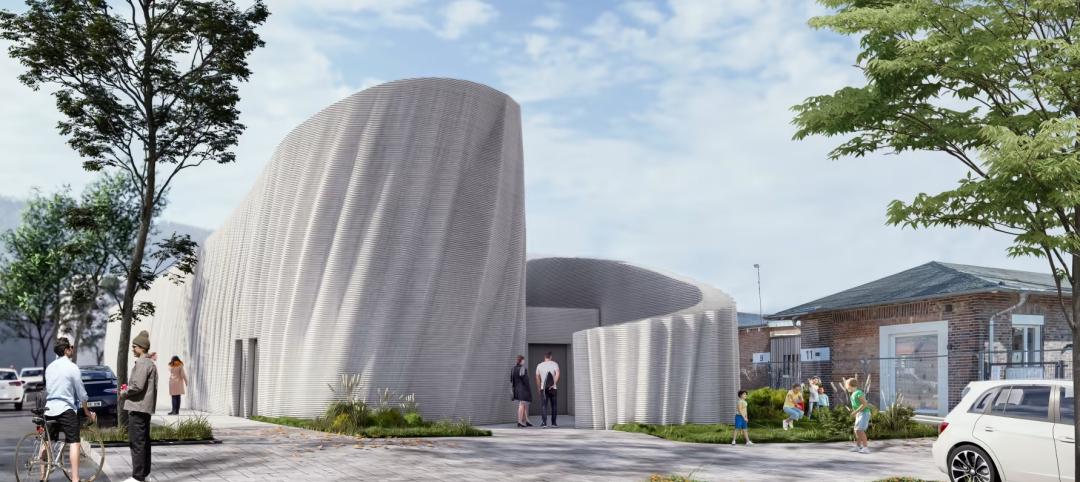As a shining symbol of civic pride in Los Angeles County, Pasadena City Hall stood as the stately centerpiece of Pasadena's Civic Center since 1927. To the casual observer, the rectangular edifice, designed by San Francisco Classicists John Bakewell, Jr., and Arthur Brown, Jr., appeared to be aging gracefully.
However, that placid exterior masked deep cracks within two of the hall's stair towers, extensive water damage, decaying art stone exterior features, and significant seismic defects.
Consequently, seismic strengthening, an M/E/P systems and ADA upgrade, restoration of internal and external areas, and landscaping were the main program elements that the Building Team, headed by the Clark Construction Group, Costa Mesa, Calif., was charged with handling.
Recent studies showed that a future earthquake could destroy portions of the building, so the decision was made to separate the historic structure from the ground through seismic isolation. The original basement floor slab was removed, a new foundation was excavated and installed, a new basement floor transfer system was put in place, and 240 friction-pendulum isolators were installed.
“This was an extremely complicated project,” said BD+C Reconstruction Awards judge K. Nam Shiu, P.E., S.E., MISE, VP, Walker Restoration Consultants, Chicago. “Installing a base isolation system on an existing building is difficult work.”
Interior walls were replaced, the hall's plaster ceilings were restored, and new finishes were applied. All the building's marble, light fixtures, quarry tile, wood doors, and woodwork were preserved, protected, or restored.
On the exterior, historical cast stone elements were refurbished, as well as exterior plaster and copper cladding on the dome and stair towers. The grounds were spruced up with new site paving, landscaping, planters, and decomposed granite walkways.
With such attention dedicated to preserving historic elements, the design and installation of new M/E/P systems had to be carefully woven into the architecture. Systems had to be integrated above existing plaster ceilings, within wainscots, and through existing structural beams in line with specific guidelines in extremely confined spaces. The Building Team had to do a significant amount of coring through concrete and steel to run utility lines; in some cases, soffits were created to conceal M/E/P components.
The Building Team benefited from expertise lent by the City Hall Restoration Oversight Committee, a team of 13 outside professionals appointed by the Pasadena City Council to monitor this important civic project. City of Pasadena officials often attended weekly meetings with subcontractors.
Not only did the design need to be tight, but the actual construction had to be extremely well coordinated, particularly in the basement, where multiple trades had to work together in limited space. Because the basement slab was a honeycomb pattern of holes and structural openings, guardrails and hole covers had to be constantly relocated and replaced during different phases of the project. The team had to exert extreme diligence to prevent any workplace incidents.
This effort paid off. Not only was the work successfully completed two months ahead of schedule, but during more than 541,000 man-hours under difficult work conditions, the project reported zero lost time incidents—an impressive feat when compared to the Bureau of Labor Statistics' 2005 national average rate of 2.6 lost time incidents per project.
Related Stories
AEC Innovators | Jun 15, 2023
Rogers-O'Brien Construction pilots wearables to reduce heat-related injuries on jobsites
Rogers-O'Brien Construction (RO) has launched a pilot program utilizing SafeGuard, a safety-as-a-service platform for real-time health and safety risk assessment. Non-invasive wearables connected to SafeGuard continuously monitor personnel to prevent heat exhaustion on jobsites, reducing the risk of related injuries. RO is the first general contractor to pilot this program.
Mass Timber | Jun 13, 2023
Mass timber construction featured in two-story mixed-use art gallery and wine bar in Silicon Valley
The Edes Building, a two-story art gallery and wine bar in the Silicon Valley community of Morgan Hill, will prominently feature mass timber. Cross-laminated timber (CLT) and glulam posts and beams were specified for aesthetics, biophilic properties, and a reduced carbon footprint compared to concrete and steel alternatives.
Engineers | Jun 5, 2023
How to properly assess structural wind damage
Properly assessing wind damage can identify vulnerabilities in a building's design or construction, which could lead to future damage or loss, writes Matt Wagner, SE, Principal and Managing Director with Walter P Moore.
Cladding and Facade Systems | Jun 5, 2023
27 important questions about façade leakage
Walter P Moore’s Darek Brandt discusses the key questions building owners and property managers should be asking to determine the health of their building's façade.
Office Buildings | May 15, 2023
Sixteen-story office tower will use 40% less energy than an average NYC office building
This month marks the completion of a new 16-story office tower that is being promoted as New York City’s most sustainable office structure. That boast is backed by an innovative HVAC system that features geothermal wells, dedicated outdoor air system (DOAS) units, radiant heating and cooling, and a sophisticated control system to ensure that the elements work optimally together.
AEC Tech Innovation | May 12, 2023
Meet Diverge, Hensel Phelps' new ConTech investment company
Thai Nguyen, Director of Innovation with Hensel Phelps, discusses the construction giant's new startup investment platform, Diverge.
3D Printing | May 12, 2023
World’s first 3D-printed medical center completed
3D construction printing reached new heights this week as the world’s first 3D-printed medical center was completed in Thailand.
AEC Tech | May 9, 2023
4 insights on building product manufacturers getting ‘smart’
Overall, half of building product manufacturers plan to invest in one or more areas of technology in the next three years.
University Buildings | May 5, 2023
New health sciences center at St. John’s University will feature geothermal heating, cooling
The recently topped off St. Vincent Health Sciences Center at St. John’s University in New York City will feature impressive green features including geothermal heating and cooling along with an array of rooftop solar panels. The geothermal field consists of 66 wells drilled 499 feet below ground which will help to heat and cool the 70,000 sf structure.
Building Technology | May 4, 2023
3D printing for construction advances in Germany
The largest 3D-printed building in Europe will have a much lower carbon footprint.
















